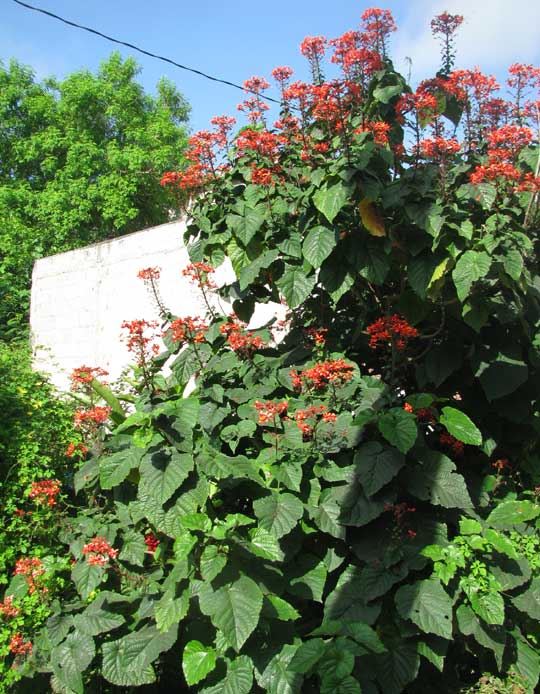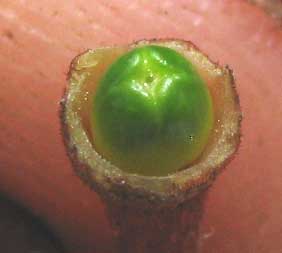Excerpts from Jim Conrad's
Naturalist Newsletter
from the August 15, 2010 Newsletter issued from Hacienda Chichen Resort beside Chichén Itzá Ruins, central Yucatán, MÉXICO; limestone bedrock, elevation ~39m (~128ft), ~N20.676°, ~W88.569°
A BIT OF JAVA IN PISTÉ
I was exploring Pisté's backstreets when I saw the 15-ft-tall (4.5 m) tree gloriously abloom with 1-¾ inch wide, red flowers shown below:

I'd never seen this kind of tree, or anything quite like it. An up-close look of the flowers didn't ring a bell, either. You can see the blossoms' five corolla lobes, four stamens and long, slender style below:

In that picture notice how young flower buds cluster along one side of the stem, or rachilla, they arise from -- they're not arranged spirally around their rachilla. Also, the rachilla curves toward its end. Those features hint of the Vervain/Borage/Phlox group of families. The five corolla lobes and four stamens suggest the Acanthus Family, but the flowers don't have bracts beneath them, which most species in that family do. To figure this tree out I had to snip off a flower, return to the hut, and "key it out" using my old, always-carried-in-the-backpack, Bailey's Manual of Cultivated Plants, just like a beginning student. It felt good to be stumped so completely by such a striking plant!
It turned out to be CLERODENDRUM SPECIOSISSIMUM, the "specio" in the species name meaning "showy," and the "issimum" being a suffix meaning "very." Native to Java, Indonesia, the species is planted in the tropics worldwide, and thus is known by many English names, the most common ones seeming to be Java Glorybower, Flaming Glorybower, Pagoda Flower and Giant Salvia. Giant Salvia is a fair name because Scarlet Sage is a Salvia, and the flowers do look like Scarlet Sage flowers, just that they're on a tree. Also, Scarlet Sage is a member of the Mint Family, and -- to my astonishment -- so is Clerodendrum speciosissimum.
My astonishment was because I'm not used to mints being trees. In fact, Bailey's Manual places the genus Clerodendrum in the Verbena Family. Only recently has genetic sequencing shifted it to the Mint Family. It's also hard to accept this tree as a mint because its ovary is not deeply four-lobed, with each lobe in time falling away as a seedlike "nutlet." If you can't picture that, take a look at Mint Family Hedge Nettle nutlets at www.backyardnature.net/mintnut.jpg.
I don't think I've ever seen a Mint Family member whose ovaries weren't deeply four-lobed. But, below, take a look at the ovary of Clerodendrum speciosissimum:

It's clearly four-sectioned, but hardly four-lobed. Well, this whole plant-family business strictly resides in human heads, and Nature makes no attempt to fit into our pigeonholes, so I think this must be one of those in-between genera not really neatly fitting anywhere.
In China Clerodendrum speciosissimum's roots and flowers are used to treat arthritis, liver and eye problems, hemorrhoids and hernias, and insomnia.
One reason we may see this species so seldom is that, from what I observed on this tree, after flowering the ovaries simply fall off without maturing into fruits bearing seeds. I read that the species spreads by root suckering. As such, it's managed to spread from cultivation at several places in southern Florida.